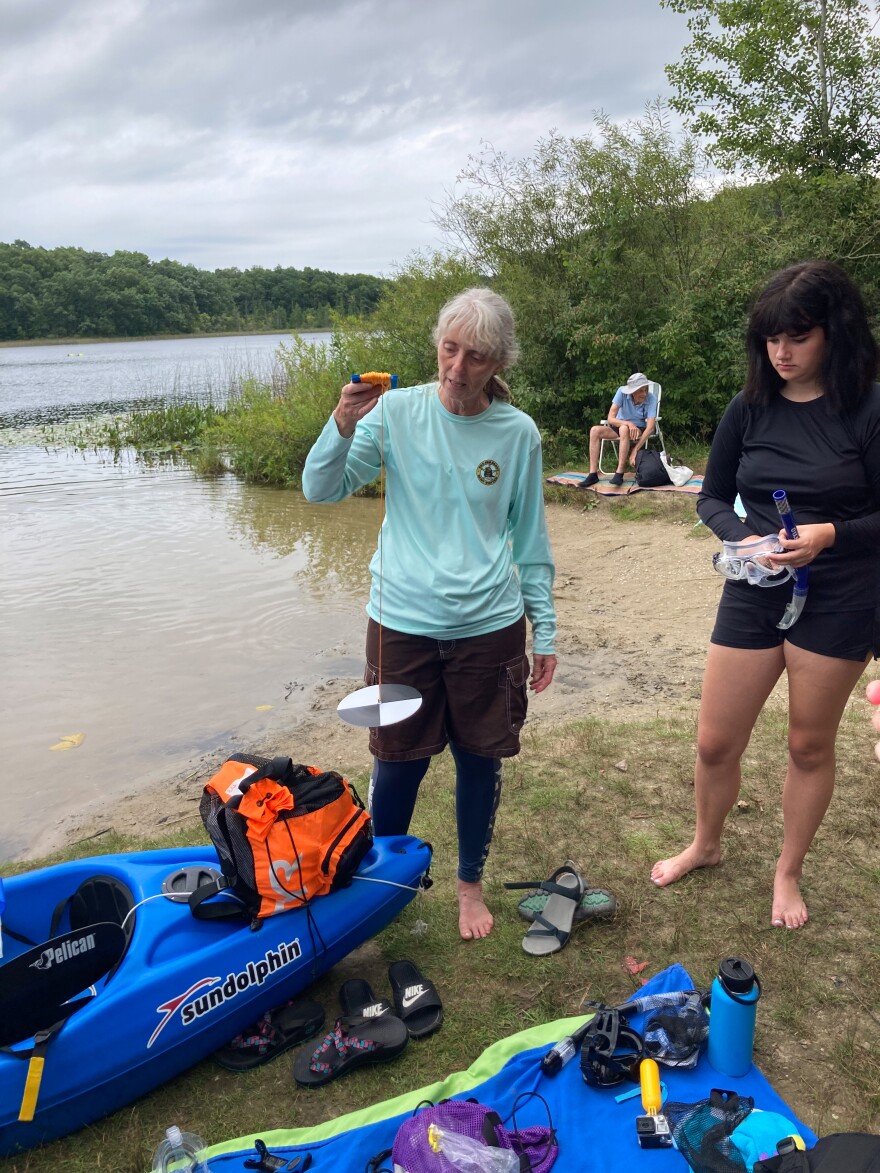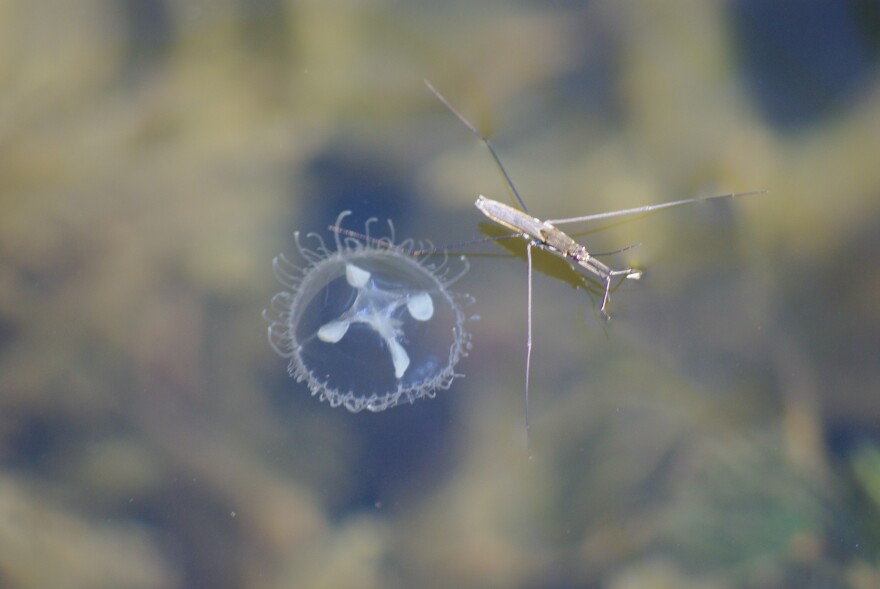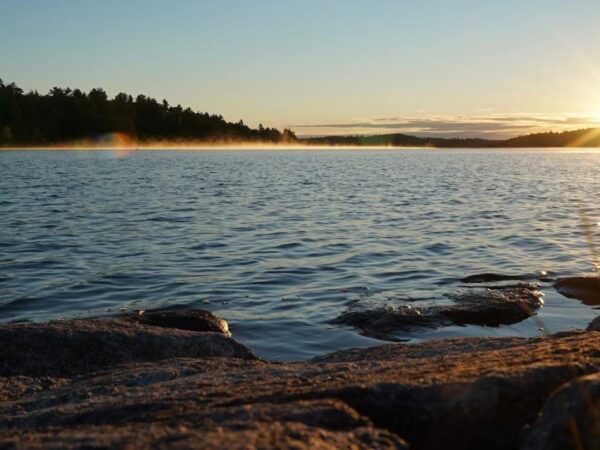
Points North is a biweekly podcast hosted by Daniel Wanschura and Morgan Springer about the land, water and inhabitants of the Upper Great Lakes.
This episode was shared here with permission from Interlochen Public Radio.
In 1933, a high schooler fishing along the Huron River in Ann Arbor, Michigan looked into the water and saw something weird. It turned out to be a freshwater jellyfish – the first ever discovered in the Great Lakes region. Later that year, there was another sighting in Lake Erie.
Researchers think the species hitched a ride here on aquatic plants shipped from China, then spread. But there’s no evidence they harm the lake ecosystems they now call home.
Since then, the jellyfish have spread across the Upper Midwest, loitering mostly in inland lakes, rivers, and streams. But we still don’t know all that much about them.
A biology professor and her field research class at Eastern Michigan University are hoping to change that. Every week, they slap on masks, snorkels, and floaties, and wade out into a southeast Michigan lake on the lookout for jellyfish.
What they find could lay the foundation for more research on freshwater jellyfish, and change how we think about invertebrates in the process.
CREDITS:
Producer: Ellie Katz
Host: Dan Wanschura
Editor: Morgan Springer
Music: Netherland, Aria Area, and Lake Victoria by Podington Bear

Students in a biology research class at Eastern Michigan University prepare to snorkel in Pickerel Lake in September 2023. The class focuses on the peach blossom jellyfish, a nonnative freshwater jellyfish now found in waters across the Great Lakes Region. (Photo: Ellie Katz / Points North)
TRANSCRIPT:
DAN WANSCHURA, HOST: Rachel Koski was working on her scuba certification at a small lake in Michigan.
RACHEL KOSKI: And we’re walking out, and there’s quite a big drop off at the lake that we were at…and then we were swimming out to the point where we were going to dive down. You know, I had my head in the water. And I just remember seeing this, like, tiny, tiny translucent animal moving in the water. And I looked at my divemaster, and I was like, what is that?
WANSCHURA: There, in the freshwater, was a single jellyfish – pulsing and floating just on the other side of her thin plastic mask.
KOSKI: I was like, What is this? This is so cool. And then, will they sting me?
WANSCHURA: At the time, Rachel was a biology undergrad at Eastern Michigan University. Only a few years later, she was devoting her entire master’s degree to the creature.
And she’s still snorkeling around small, murky lakes to look for an elusive freshwater jellyfish.
This is Points North, a podcast about the land, water and inhabitants of the Great Lakes. I’m Dan Wanschura.
Today, producer Ellie Katz tries to track down the peach blossom jellyfish, and explores why, more than a century after the species hitched a ride to the Great Lakes, we still don’t quite understand it. That’s right after this.
(sponsor messages)
ELLIE KATZ, BYLINE: Had you heard of freshwater jellyfish before taking this class?
ALAINA MCCALLOP: Never. I was so excited. I guess they’re, like, this big.
KATZ: Alaina McCallop is curving her fingers to the size of nickel. We’re in the middle of Pickerel Lake, about a half hour from Ann Arbor.
We’re on the lookout for tiny, freshwater jellyfish as part of a biology class at Eastern Michigan University.
Alaina and her girlfriend Grace Halcrow spent their summer getting ready for this class by diving for change in the swimming pool.
GRACE HALCROW: When we were at home, we were just throwing coins to the bottom of our pool and trying to see if we could see them because…
MCCALLOP: Yeah, we didn’t know the size of them yet and so then when we looked it up, we were like, “Oh.”
KATZ: It turns out small coins in a pool are a little easier to spot than small jellyfish in a lake. Alaina and Grace stick their faces back in the water.
HALCROW: It’s literally just…
MCCALLOP: It’s just green.
HALCROW: Yeah, it’s just green.
MCCALLOP: But then you put your hand in front of your face and you’re like, “Oh, it is clear.” So it’s just that deep, and then you’re like, “Woah.”
HALCROW: But then that makes you feel better because, it’s like, if something is actually close to you or anything, you would see it.

This species of freshwater jellyfish, Craspedacusta sowerbii, is native to the Yangtze River valley in China. They grow to be about the size of nickel once they enter their “medusa” life stage, or have the classic jellyfish bell shape. (Photo: Dave Head / USGS)
KATZ: Over the past century, the little jellyfish has spread to every continent on earth except Antarctica.
They’ve been found in every state except Alaska, Wyoming, Montana, and the Dakotas. They’re seemingly all over the place – particularly the calm, plankton-rich, inland waters of the Great Lakes region.
And yet they’re still so hard to find. It’s the first day in the field, and there’s nothing in sight.
The class is led by Rachel Koski and her thesis advisor, Cara Shillington, who’s a biology professor at Eastern Michigan. Cara says the point is to leave the lab and study the jellyfish in its environment.

Cara Shillington, a biology professor at Eastern Michigan University, demonstrates how to use a Secchi disk. The device is used to measure water clarity. (Photo: Ellie Katz / Points North)
CARA SHILLINGTON: When you’re out there, the questions come. It’s like, why are they doing this? You know, where are they? You know, how do we trace them? What happens when they go up? Or down? Are they feeding? Are they not feeding? Are they clumped together? Are they not clumped together? And so all of that, until you see them, you don’t even know.
KATZ: There’s plenty of things we do know about this species. Like, we know they sting, but their tentacles are too small for humans to feel.
We know that despite the word “jellyfish,” they’re not actually a fish, so Cara says “jelly” instead. We know how they feed, how they reproduce, what their lifecycle looks like.
But there’s also a lot we don’t know. Like why one year there’ll be hundreds in a lake, and then the next year, they’re entirely gone.
We aren’t really sure how weather changes their populations or how freshwater jellies even evolved. And it’s not totally clear why they pop up in some spots and not others.
SHILLINGTON: We’ve got some arm waving ideas, but we don’t really know. So, you know, if we get to do this for multiple years, will we have a better way of predicting when we might see these organisms based on, you know, water quality parameters or weather conditions?
KATZ: At Pickerel Lake, we’re still not any closer to finding out because there’s not a single jelly around.

Eastern Michigan University students snorkel in Pickerel Lake looking for freshwater jellyfish. (Photo: Ellie Katz / Points North)
STUDENT: Sometimes I see something so small, I’m like, I don’t even know what I’m looking at, but I don’t think it’s what we’re looking for.
SHILLINGTON: I swear I saw something and it looked like it was doing the pulsing.
STUDENT: I’ve seen that too.
STUDENT: No, I think it’s some little water bug.
STUDENT: The little diving beetle?
STUDENT: I don’t know… very small, very small.
STUDENT: I was faked out by a dead spider in the water earlier. It was white, and I was like, “Oh my god.”
KATZ: Class ends, but everyone comes up empty handed.
STUDENT: No jellyfish today, but there’s other creatures.
KATZ: They wade out of the lake and head home.
It’s a little surprising how much we don’t know, especially considering the first jelly in the region was found almost exactly a hundred years ago.
SHILLINGTON: This is a species that came from China in the 1930s. The suggestion is that they came over with aquatic plants, and were released into the lakes and then have just been moving across the states getting into different lakes.
KATZ: According to a University of Michigan newspaper, a high schooler saw the first tiny, pulsating creature. They were fishing along the Huron River in Ann Arbor, and turned the jelly over to a zoologist at the University of Michigan.
But instead of whisking it off to a lab, dousing it with a solution, and preserving it in the archives, the zoologist did something surprising.
He put the jelly in a small aquarium display inside of a drugstore window on campus. Anyone walking by could look in and briefly see this little alien – this slimy, translucent, nickel-sized piece of a world floating just on the other side of the water.
A century later, the same species is still loitering in the Great Lakes region. And it’s still kind of an enigma.
It’s day two at the lake. There’s all sorts of water bugs, and aquatic plants, and fishes, but still no jellies.
Then, off in an unexplored corner of the lake, Alaina and Grace start waving.
HALCROW: I saw it go, like, right in front of my face. But then I couldn’t find it, ‘cause I came up. Do you see it?
KATZ: Oh my gosh, it’s like, the size of your pinky fingernail.
HALCROW: Yeah, it was so tiny. It just went right in front of me and I could barely see it. And then I went down again and found it.
MCCALLOP: Do you guys want to go over there and look for more?
KATZ: Tiny jellies start popping up all over the place.
STUDENT: I got one!
STUDENT: You got one? Yay!
SHILLINGTON: There it is, look! It’s swimming up. You see it there?
MCCALLOP: This one’s a little bigger.
SHILLINGTON: Oh, I got one too!
KATZ: They scoop them up in little bags like when you buy a fish from the pet store. Right now they’re itty bitty, but they’ll grow to be about the size of about a nickel over the next several weeks. They’ll eat, lay their eggs, and then they’ll die.
Some beachgoers see all the action and come check it out.
BEACHGOER: It looks like a sand dollar… a translucent sand dollar. It has that pattern. It’s beautiful.
BEACHGOER: Do you guys want to see one?
BEACHGOER: Jellyfish? Really? I didn’t know we had jellyfish.
KATZ: We got jellyfish!
BEACHGOER: I’ll be darned.
KATZ: You want to see?
BEACHGOER: Yeah!

A freshwater jellyfish next to a water glider. There’s no evidence freshwater jellyfish are harmful to the Great Lakes ecosystems they now call home. (Photo: Biotom / Wikimedia Commons)
KATZ: Somehow these jellies have crossed continents, settled in our unsalted ponds and lakes, and yet we still don’t know that much about them.
It could be because there’s no evidence these non-native species hurt Great Lakes ecosystems. So there’s not much motivation to change things. It could be because they’re not as sexy as other big aquatic animals, like sharks.
But Cara and Rachel think there’s another reason.
KOSKI: Typically, a lot of research is put into vertebrates. There is, like, millions of species of invertebrates…There’s just so much more time, money, effort put into vertebrates.
KATZ: They say invertebrates just aren’t quite as lovable as our spine-bearing cousins. Maybe that preference is built into our biology. But it’s also built into what we learn about the world growing up. Just think about it:
Worms versus whales. Insects versus elephants. Zooplankton versus zebras.
If they’re not outright villains, invertebrates are just kind of boring, at best. But scientists who do bother studying them find over and over again that they’re the building blocks of our world.
SHILLINGTON: How can you not love them? The diversity is just amazing. The varieties of lifestyles, of what they do, of how they look, of the structure…is just absolutely phenomenal. How can you ignore 99% of the animal world and focus on just 1%? So, how can you not want to know more?
KATZ: Freshwater jellies probably aren’t the invertebrate heroes of our dreams, but they are a gateway: a gateway into the understudied, underappreciated world of invertebrates. And that’s plenty.
Catch more news at Great Lakes Now:
Points North: Dirty Laundry, Invasive Species, and the Limitations of Knowledge
‘Solar grazing’ is a way for farmers and solar companies to use land. But there are challenges
Featured image: Kurt “Mountain Man” Steiner warms up in advance of the 55th Mackinac Island Stone Skipping Tournament on July 4, 2023. (Photo credit: George Terrizzi / Points North)


